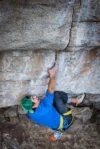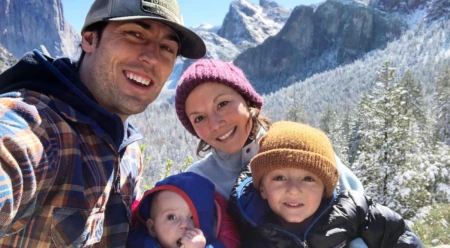The Only Constant Is Change: Sonnie Trotter Reflects on His Life So Far
I’m sitting on a sunny bench in some random park in central Oregon holding my eight-month-old daughter in my arms and watching my four-year-old son launch himself down a slide. We’ve been on the road as a family for nearly a month now, and the daily hunt for a decent playground is often as essential as the grind for a strong cup of coffee. We play in the mornings and climb in the afternoons.
In the background, there’s a tall man throwing a Frisbee for his lean, sandy colored dog. I focus on the four-legged animal as he bounds and rips across the dewy green grass, his slobbering tongue dangling from one side of his mouth, and then tosses himself in the air with open jaws to snatch the disc from the sky. It’s a marvelous thing to watch. His age is irrelevant; he is more than happy, he is elated.
I loosely understand the concept that age is relative, and while I’m certainly not old, I’m not young anymore either (again, relative) and I like to believe I’ve learned a few things over the last 38 years under the sun—in particular, a few things about change. Change is a fascinating thing. Some people embrace it with wonder, some hate it and hold a grudge for years. And some people downright refuse it, they fight it for decades. But change is nonetheless inevitable and, in my experience anyway, I have found it easier when confronting change to take a deep, calm breath, look into the unknown and smile, for it is the only constant through all of life’s phases.

Family Man (5.14b) is a first ascent Sonnie did the same year his first child Tatum was born. Skaha, British Columbia. Photo: Gabe Zamorano
In 1998, I dangled from my rope on a massive cliff face, my body limp and depressed. I was desperately close to climbing a fairly hard route (for the day), and in record time, but I made a classic mistake on the final exit moves. I got sloppy with my footwork and took flight down the orange and black colored rock. If successful, I believed the ascent would have helped mark my “arrival” as a top climber. Nobody else had yet done what I was trying to do, not on this climb anyway. That was foolish to think, but I suppose it was my way of proving to myself that I was a contender in the wide world of vertical sports. And like most teenagers, I was hungry for some sense of belonging and approval. In my mind, at that particular moment, I had just blown the World Series.
My 18-year-old lungs let out a childish scream. I pulled down my rope with rage and bit my lip to hold back the tears. When the day ended, and my friends and I went back to the campground, I skipped dinner and went for a long walk so I could avoid facing anyone for the rest of the night. Climbing meant everything to me, and each day a new route would be my world. I’m not necessarily proud of it, it was just who I was back then. I was passionate. And it would take nearly two days to vent the frustration after such a massive disappointment.
I had this naïve belief that failure was a step backwards, so I stuck with every climb I tried until I did them. It was a fragile phase. I was building a castle of confidence, one climb at a time, and to fail outright might crumble the whole thing. So I never tried anything I didn’t think I could do. That too has changed.

Sonnie on his very first road trip to Rifle, Colorado, when he was 18 years old. No phone, no email, no permanent address. Photo: Sonnie Trotter Collection
In the early years, I believed that maybe I would be content if I climbed this particular route or led that crack or bagged a far-off summit. So I chased climb after climb, year after year. We sometimes have a way of making unimportant things seem important in our lives. But as time passed, I began to notice that it wasn’t the achievement at all that would make me content, it was always the process. I loved the process. Like a dog chasing a Frisbee, no matter what our age is, or what phase of life we are in, or what grade of climb we are trying, there’s comfort in knowing it’s natural for us to want to reach goals, to strive for different objectives and to run like hell to catch up to them. It’s the process that makes it fun.
So the lesson I think I’ve learned is this: There is no one climb that will truly satisfy our need to go climbing or make us feel complete. There is always another project, another style, another crag, another state or country to visit. It never ends and I love knowing that. No longer do I see climbing as a way for me to feel satisfied, because ultimately I am a lifer, a lifelong climber. It’s not the Frisbee I am catching that brings me joy, it’s everything that comes with it—the fresh air, the people, the movement, the playfulness. Each day when I go out and do what we all love, no matter how many times that is throughout the year, I still get that tongue-dangling feeling. I press up on my toes, reach for that far away finger lock and pull up into a new sequence to solve. A new set of moves, a fresh game to play, that’s what I love. That’s what I have always loved and that is ultimately what I will love 20 years from now.
Goals, dreams and desires, they are wonderful. They’re what keep our tails wagging and get us out to the playground each day. But if I could, I would tell my younger self not to dwell on the outcome so much—although I’m not sure my younger self would have listened. The castle of confidence is built over time, not only through success but also through failure. That’s a tough one to learn, I think. There’s always another climb and another Frisbee to help us learn that there’s never “enough.” And I think that’s fantastic. Besides, what would climbing be if we achieved our ultimate climb? What then? Just quit?
Never.
“Dad!” my son yells at me from across the park. “Look, Dad, I’m the king of the castle and you’re the dirty rascal!” He laughs and hangs from his arms at the top of the tower before taking another rip down the yellow slide. My daughter giggles and scratches at her eyes. Nap time, I’m sure of it.
Like I said, change is the only constant.

